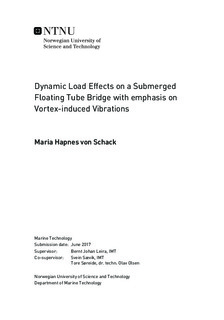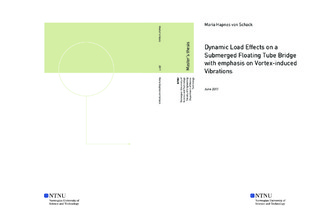| dc.description.abstract | A ferry-free highway is under planning of the Norwegian Public Roads Administration on the south-west coast of Norway. Many of the fjords are characterized as very deep and wide, resulting in a need for innovative, new technology for todays bridges and tunnels.
%and because of this regular bridges and tunnels will need innovative new technology.
Submerged Floating Tube Bridges (SFTBs) are an alternative solution for fjord crossing and have been considered for some of these crossings.
The objective of this thesis has been to survey the different forms of dynamic load effects on a proposed tether-stabilized SFTB-concept for the 5 km long Bjørnafjord. The concept is made by the design group Dr.techn. Olav Olsen, Reinertsen and Norconsult during an Assessment Study. Vortex-induced Vibrations (VIV) have been analysed by the software Vivana and compared with empirical models provided by DNV GL. A model of the SFTB was created in Sima/Riflex. A few dynamic analyses have been performed in order to compare response with response from analyses done by the design group.
The reliability of results from VIV-analyses are limited by the used software Vivana. The bridge consist of tubes and tethers in tandem, and in reality the inflow current velocity of the second tube will be affected by the first tube. This is not included in Vivana, and hence one tube and one tether were analysed individually.
It was found that the onset for in-line VIV for the tube was at a return period of 7 years with an amplitude of 23 cm. The amplitudes of a 100 year current were found to be 0.86 m and the resulting maximum moment was estimated to be about 25 \% of moments from the wave analyses of a 100 year return period. Horizontal accelerations for the bridge are within requirements. No cross-flow VIV was found for both tube and tether. VIV was not found to be of a concern for tethers due to low amplitudes and high fatigue life. However, the response amplitude for the tethers is seen to increase with with the decrease in tension and this may be critical for smaller tensions. The DNV GL in-line model is in general conservative compared to the amplitudes found from Vivana.
Dynamic wave analyses were conducted for both wind-sea, and for wind-sea and swell. It was observed that swell is important to include in the analysis, as on this depth, it is the dominant wave. Envelopes of the maximum and minimum response was compared to results from the analysis done by the design group. The tension in the tethers were found to be positive for all performed dynamic analyses, always maintaining the vertical stability of the bridge. | |

